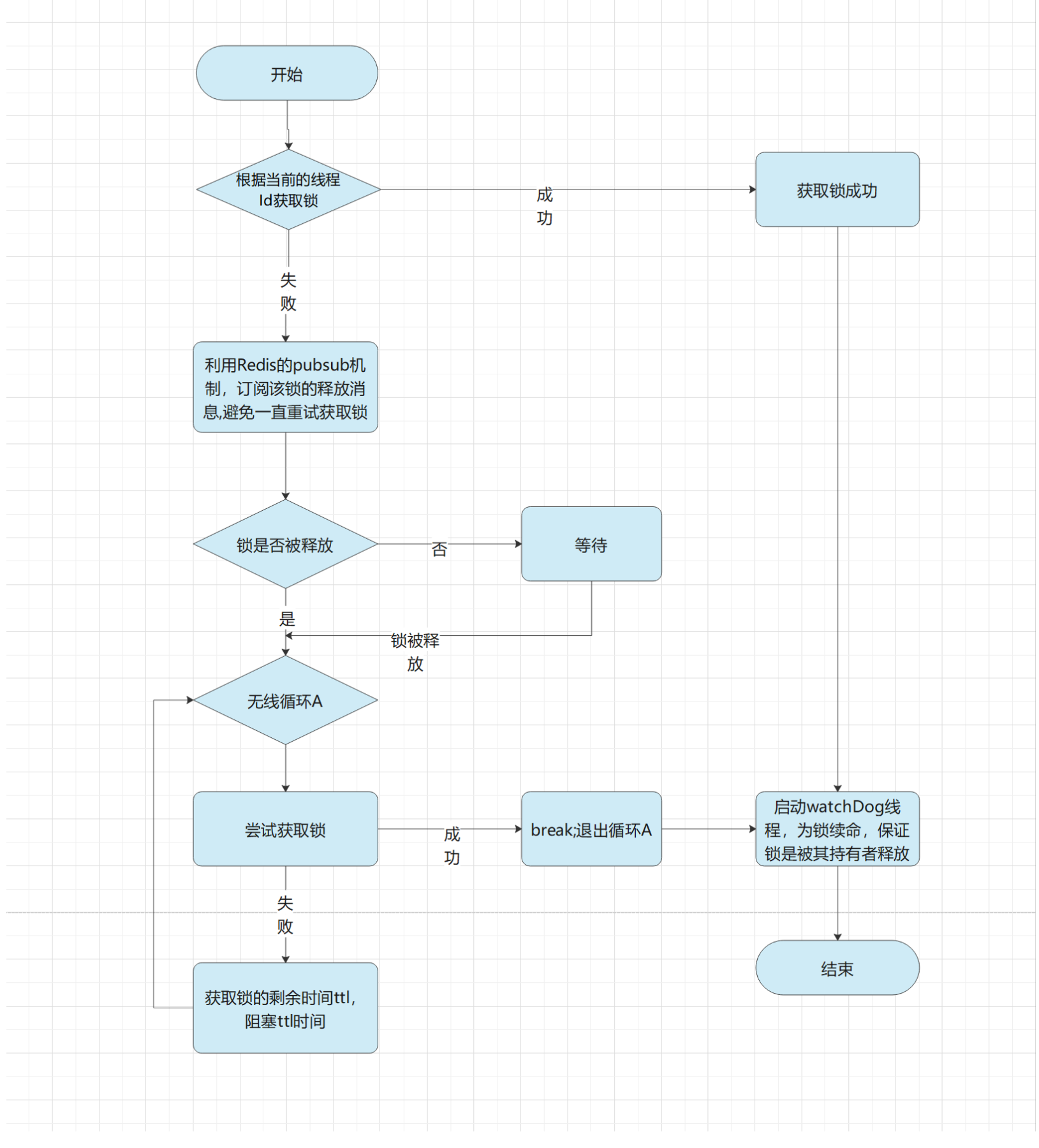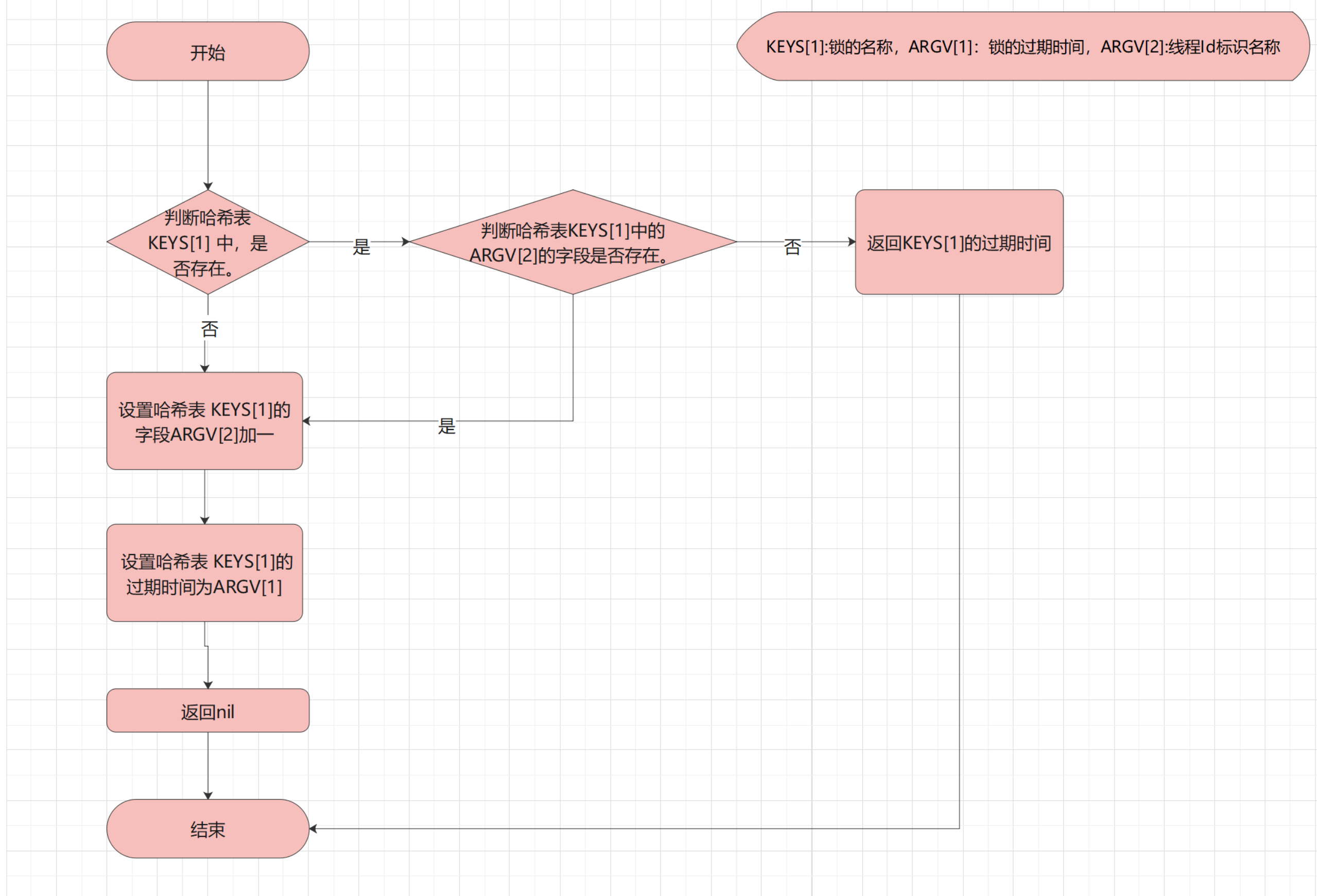redission分布式锁的使用
RLock lock = redissonClient.getLock("myLock");
lock.lock();
try {
System.out.println("aaa");
} catch (Exception e) {
System.out.println("bbb");
} finally {
lock.unlock();
}
获取锁的流程图

加锁代码流程(org.redisson.RedissonLock)
public void lock() {
try {
//参数意义 -1 代表不自动释放锁,null时间单位,false加锁期间线程被中断将抛出异常
lock(-1, null, false);
} catch (InterruptedException e) {
throw new IllegalStateException();
}
}
/**
* 加锁
* @param leaseTime 锁的使用时间,超过该时间,锁便自动释放
* @param unit 时间单位
* @param interruptibly 加锁期间是否可以被中断
* @return void
* @author liekkas 2021-02-27 15:46
*/
private void lock(long leaseTime, TimeUnit unit, boolean interruptibly) throws InterruptedException {
//获取当前线程的Id
long threadId = Thread.currentThread().getId();
//加锁,如果ttl为null,则说明ttl(time to live)为空,加锁成功,否则加锁不成功。
Long ttl = tryAcquire(-1, leaseTime, unit, threadId);
//加锁成功,直接返回
if (ttl == null) {
return;
}
//加锁失败,订阅该线程,释放锁的时候会发布一个消息,锁没有释放的时候则会等待,直到锁释放的时候会执行下面的while循环,重新竞争锁。此处是用了异步的模式。
RFuture<RedissonLockEntry> future = subscribe(threadId);
if (interruptibly) {
commandExecutor.syncSubscriptionInterrupted(future);
} else {
commandExecutor.syncSubscription(future);
}
try {
while (true) {
//锁被释放,重新竞争锁
ttl = tryAcquire(-1, leaseTime, unit, threadId);
// 竞争获取锁成功,退出循环,不再竞争。
if (ttl == null) {
break;
}
// 竞争获取锁失败,则排队等待所释放,重新竞争锁。
if (ttl >= 0) {
try {
//利用信号量机制阻塞当前线程ttl时间,之后再重新获取锁,如果当前线程被中断,则抛出 InterruptedException异常
future.getNow().getLatch().tryAcquire(ttl, TimeUnit.MILLISECONDS);
} catch (InterruptedException e) {
if (interruptibly) {
throw e;
}
future.getNow().getLatch().tryAcquire(ttl, TimeUnit.MILLISECONDS);
}
} else {
if (interruptibly) {
future.getNow().getLatch().acquire();
} else {
future.getNow().getLatch().acquireUninterruptibly();
}
}
}
} finally {
//竞争锁成功后,取消订阅该线程Id事件
unsubscribe(future, threadId);
}
}
/**
* 利用future模式异步返回锁的剩余生存时间
* @param waitTime 等待时间
* @param leaseTime 锁的使用时间,超过改时间,锁便自动释放
* @param unit 时间单位
* @param threadId 当前线程Id
* @return 锁的剩余生存时间
* @author liekkas 2021-02-27 15:46
*/
private Long tryAcquire(long waitTime, long leaseTime, TimeUnit unit, long threadId) {
return get(tryAcquireAsync(waitTime, leaseTime, unit, threadId));
}
/**
*
* @param waitTime 等待时间
* @param leaseTime 锁的使用时间,超过改时间,锁便自动释放
* @param unit 时间单位
* @param threadId 当前线程Id
* @return 锁的剩余生存时间
* @author liekkas 2021-02-27 15:46
*/
private <T> RFuture<Long> tryAcquireAsync(long waitTime, long leaseTime, TimeUnit unit, long threadId) {
//如果锁的租用时间不为-1,则直接获取锁,到时自动释放锁。
if (leaseTime != -1) {
return tryLockInnerAsync(waitTime, leaseTime, unit, threadId, RedisCommands.EVAL_LONG);
}
//如果锁的租用时间为-1,则利用默认的租用时间30s,获取锁
RFuture<Long> ttlRemainingFuture = tryLockInnerAsync(waitTime,
commandExecutor.getConnectionManager().getCfg().getLockWatchdogTimeout(),
TimeUnit.MILLISECONDS, threadId, RedisCommands.EVAL_LONG);
ttlRemainingFuture.onComplete((ttlRemaining, e) -> {
if (e != null) {
return;
}
// 获取锁成功,启用watchDog,自动为锁延长寿命,保证该锁被其持有者释放。
if (ttlRemaining == null) {
scheduleExpirationRenewal(threadId);
}
});
return ttlRemainingFuture;
}
lua脚本加锁流程图

/**
* 使用lua脚本加锁
* @param waitTime 等待时间
* @param leaseTime 锁的使用时间,超过改时间,锁便自动释放
* @param unit 时间单位
* @param threadId 当前线程Id
* @param command 执行lua脚本命令
* @return 锁的剩余生存时间
* @author liekkas 2021-02-27 15:46
*/
<T> RFuture<T> tryLockInnerAsync(long waitTime, long leaseTime, TimeUnit unit, long threadId, RedisStrictCommand<T> command) {
internalLockLeaseTime = unit.toMillis(leaseTime);
/**
* nil相当于java的null,后面描述为了方便就用null代替nil
* KEYS[1]:锁的名称,ARGV[1]:锁的过期时间,ARGV[2]:线程Id标识名称
* lua脚本的逻辑:
* 首先判断KEYS[1]是否存在,
* 如果不存在,则利用hincrby命令把KEYS[1]的ARGV[2]的值加一,并且设置KEYS[1]的
* 的过期时间为ARGV[1],返回null.
* 如果KEYS[1]存在,则利用hexists判断KEYS[1]的ARGV[2]是否存在,
* 如果存在,则利用hincrby命令把KEYS[1]的ARGV[2]的值加一,并且设置KEYS[1]的
* 的过期时间为ARGV[1],返回KEYS[1]的存活时间。
*/
return evalWriteAsync(getName(), LongCodec.INSTANCE, command,
"if (redis.call('exists', KEYS[1]) == 0) then " +
"redis.call('hincrby', KEYS[1], ARGV[2], 1); " +
"redis.call('pexpire', KEYS[1], ARGV[1]); " +
"return nil; " +
"end; " +
"if (redis.call('hexists', KEYS[1], ARGV[2]) == 1) then " +
"redis.call('hincrby', KEYS[1], ARGV[2], 1); " +
"redis.call('pexpire', KEYS[1], ARGV[1]); " +
"return nil; " +
"end; " +
"return redis.call('pttl', KEYS[1]);",
Collections.singletonList(getName()), internalLockLeaseTime, getLockName(threadId));
}
锁的释放流程
lua脚本释放锁的流程图

@Override
public void unlock() {
try {
get(unlockAsync(Thread.currentThread().getId()));
} catch (RedisException e) {
if (e.getCause() instanceof IllegalMonitorStateException) {
throw (IllegalMonitorStateException) e.getCause();
} else {
throw e;
}
}
public RFuture<Void> unlockAsync(long threadId) {
RPromise<Void> result = new RedissonPromise<Void>();
//释放锁
RFuture<Boolean> future = unlockInnerAsync(threadId);
future.onComplete((opStatus, e) -> {
//取消锁的延续时间
cancelExpirationRenewal(threadId);
if (e != null) {
result.tryFailure(e);
return;
}
if (opStatus == null) {
IllegalMonitorStateException cause = new IllegalMonitorStateException("attempt to unlock lock, not locked by current thread by node id: "
+ id + " thread-id: " + threadId);
result.tryFailure(cause);
return;
}
result.trySuccess(null);
});
return result;
}
protected RFuture<Boolean> unlockInnerAsync(long threadId) {
/**
* nil相当于java的null,后面描述为了方便就用null代替nil
* KEYS[1]:锁的名称,KEYS[2]:发布订阅消息的管道名称,
* ARGV[1]:发布的消息内容,ARGV[2]:锁的过期时间,ARGV[3]:线程Id标识名称
* lua脚本的逻辑:
* 首先判断KEYS[1]的ARGV[3]是否存在,
* 如果不存在,直接返回null,确保锁只能被持有的释放.
* 如果存在,则KEYS[1]的ARGV[3]的值减一,
* 如果ARGV[3]仍然大于0,由于是可重入锁,则说明该线程仍然持有该锁,
* 重新设置过期时间,返回0结束。
* 如果ARGV[3]小于等于于0,则删除KEYS[1],并发布KEYS[2],ARGV[1]消息,该锁已释放。返回1结束。
* 如果存在,则利用hincrby命令把KEYS[1]的ARGV[2]的值加一,并且设置KEYS[1]的
* 的过期时间为ARGV[1],返回KEYS[1]的存活时间。
*/
return evalWriteAsync(getName(), LongCodec.INSTANCE, RedisCommands.EVAL_BOOLEAN,
"if (redis.call('hexists', KEYS[1], ARGV[3]) == 0) then " +
"return nil;" +
"end; " +
"local counter = redis.call('hincrby', KEYS[1], ARGV[3], -1); " +
"if (counter > 0) then " +
"redis.call('pexpire', KEYS[1], ARGV[2]); " +
"return 0; " +
"else " +
"redis.call('del', KEYS[1]); " +
"redis.call('publish', KEYS[2], ARGV[1]); " +
"return 1; " +
"end; " +
"return nil;",
Arrays.asList(getName(), getChannelName()), LockPubSub.UNLOCK_MESSAGE, internalLockLeaseTime, getLockName(threadId));
}
总结
以上就是redission的加锁和释放锁的流程,从阅读源码的过程中也学到了很多设计思想,对以后的编码大有裨益!




